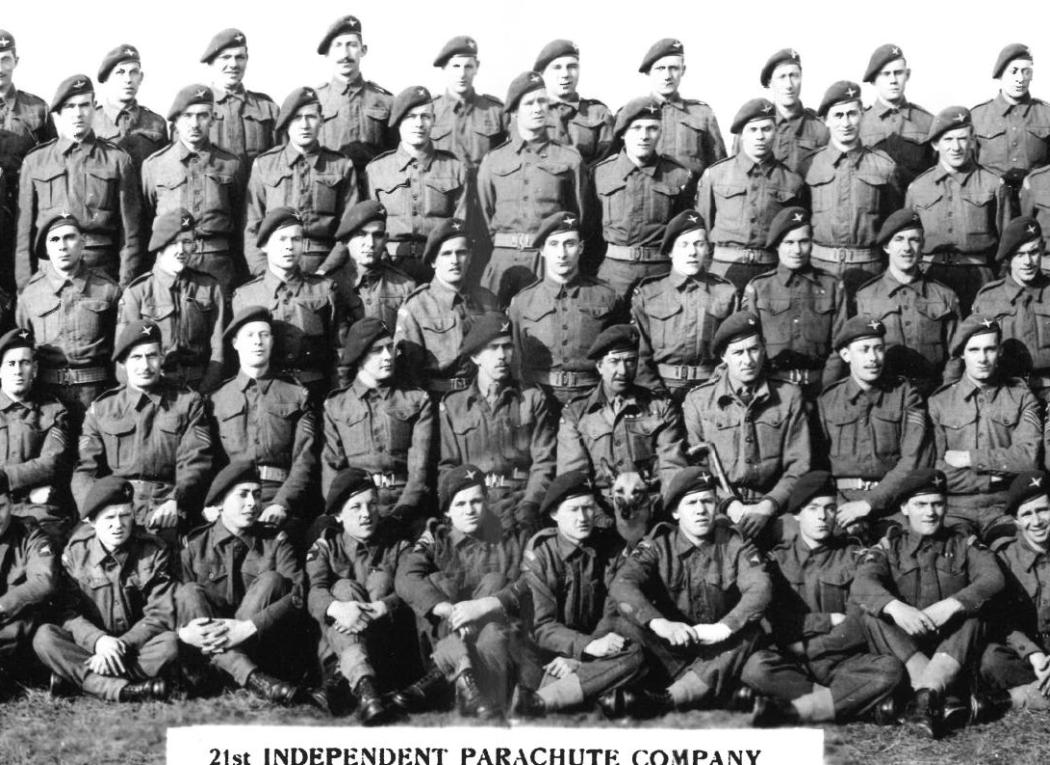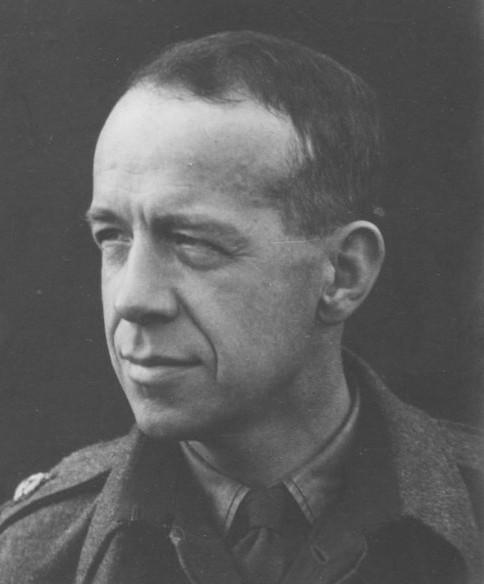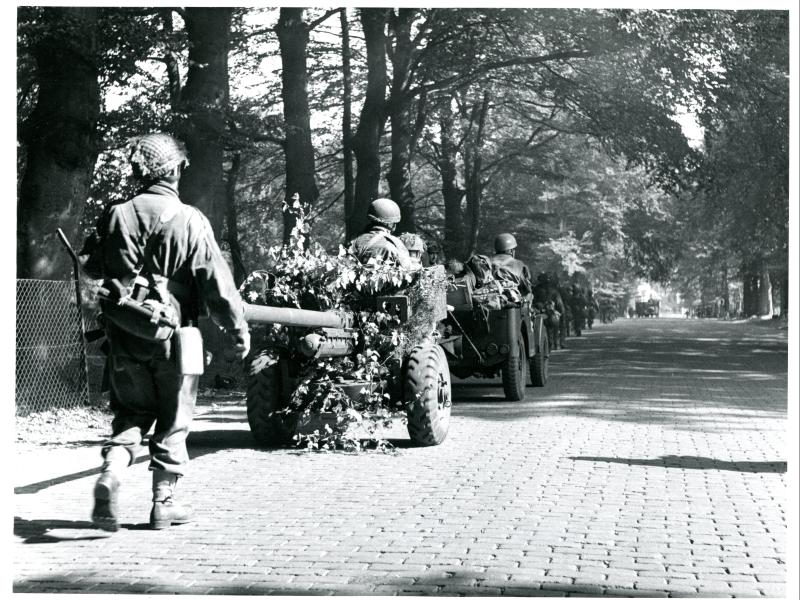Jewish Refugees serving as 1st Airborne Division Pathfinders


Major John Lander TD, BSc. (Airborne Assault Museum/Paradata)
The Role of the 21st Independent Parachute Company
The men of the 21st Independent Parachute Company were the Pathfinders of the British 1st Airborne Division. They were an elite, highly specialized group, whose role was to drop on the planned landing zones before the main Airborne force, mark out the zones using electronic beacons, lights and high-visibility panels, and guide in the main force.
The 21st Independent Parachute Company was formed at Larkhill Barracks, Wiltshire, in June 1942. It was the world’s first dedicated parachute pathfinder unit.1 The Company was formed by Major John Lander, who was a First World War veteran. He qualified as a military glider pilot in 1941 but was later grounded because of poor eyesight. He volunteered for parachute training and proposed the use of pathfinder paratroops. Their role would be to land on the planned drop zones half an hour before the main body of airborne troops, clear any obstacles from the zone that would impede glider landings, set up beacons to pinpoint the drop zones for the incoming aircraft, and provide an element of security from enemy interference.2
In June 1942, Major Lander was instructed to form an independent parachute company to undertake the pathfinder role, and his initial volunteers were trainee glider pilots who had not completed their flying courses for one reason or another. Candidate pathfinders had to meet the highest physical and psychological standards; success in the rigorous selection process led to a very strong sense of camaraderie within the Company. Major Lander expected his men to discipline themselves, work hard at all times, and achieve high standards of smartness and cleanliness without supervision. He treated his men as equals and encouraged them to exercise initiative, discuss problems and make suggestions for improving training. His approach engendered a fierce pride within the unit and its members achieved very high standards of behaviour, smartness and discipline, both in and out of barracks. The ultimate sanction for those failing to meet Lander’s exacting standards was to be returned to their previous unit.1
- 1
Mark Hickman, ‘21st Independent Parachute Company’, Pegasusarchive.org <https://www.pegasusarchive.org/arnhem/batt_ind_coy.htm> [accessed 25 February 2025].
- 1
Paradata, ‘John Lander’, Paradata.org.uk <https://www.paradata.org.uk/people/john-lander> [accessed 25 February 2025].
- 2
Ibid.

Major John Lander’s grave in Catania War Cemetery, Sicily. (Airborne Assault Museum/Paradata)
Sadly, John Lander was killed in action, aged 47, when the aircraft he was flying in was shot down over Sicily in July 1943. He was the only fatal casualty suffered by the 21st Independent Parachute Company during the invasion of Sicily.
Major Bernard ‘Boy’ Wilson, Officer Commanding, 21st Independent Parachute Company. (Pegasus Archive)
Major John Lander was succeeded by Major Bernard ‘Boy’ Wilson, who commanded the Company at Arnhem during Operation MARKET GARDEN. Its performance at Arnhem was exceptional, and its men were awarded one Distinguished Conduct Medal, two Military Crosses, five Military Medals and a Dutch Bronze Lion; for his leadership, Major Wilson was awarded the Distinguished Service Order and promoted to Lieutenant Colonel.4 Lieutenant General Frederick Browning, commander of the First British Airborne Corps during MARKET GARDEN, wrote to Major Wilson, stating:
I have heard on every side how outstandingly your Company has done. To have earned this special praise from such gallant a body can only mean one thing - that your unit is unsurpassed by any other in the world. Please tell your chaps what a terrific reputation they have earned.5
- 4
Mark Hickman, ‘21st Independent Parachute Company’, Pegasusarchive.org <https://www.pegasusarchive.org/arnhem/batt_ind_coy.htm> [accessed 25 February 2025].
- 5
Ibid.
Jewish Refugees from Germany and Austria
There were many refugees from European countries in the United Kingdom during World War II. Despite their status as 'enemy aliens', they were permitted to join the British Army within the first few months of war.6 However, they were generally not permitted to enlist into any regiment or service other than the Pioneer Corps.7 This policy changed in spring 1943 when refugees were allowed to volunteer for most units of the Army. Some ardent anti-Nazi refugees wanted to make very active contributions to combat operations, and volunteered for Airborne and Commando units.
Leading a unit designed to be dropped far behind enemy lines, Major John Lander certainly appreciated the value of soldiers who could speak foreign languages. He saw refugee volunteers as ideal candidates for the Pathfinders, and it was not long before he recruited a number of them into his Company. By the time of the Arnhem landings in September 1944, 25 of the 186 men in the Company were Jewish Germans and Austrians.8
The Nazis’ hatred for the Jewish race, and their determination to wipe it out, made the work of Jewish personnel in the Allied forces particularly hazardous. Allied prisoners-of-war (POWs) in German captivity could expect to be treated in accordance with the 1929 Geneva Convention on POWs, which had been signed and ratified by Germany. However, any Jewish personnel captured could not be sure whether the Germans would adhere to the Geneva Convention, or would apply Nazi racial policies instead. Jewish refugees who had already escaped the clutches of the Nazis once might attract particular hatred from their German captors. In an effort to hide their German and Austrian backgrounds, many of the Jewish refugees serving in the British forces adopted British names, and there is no doubt that it took a very special courage to volunteer for front-line operations with these backgrounds.
Click on the links below to see information at Paradata (Airborne Assault Museum) on these German Jewish refugees who joined the 21st Independent Parachute Company:
Corporal Harold Bruce (Harold Schilling)
Private Walter Landon (Walter Lewy-Lingen)
Corporal John P Rodley (Hans Rosenfeld)
Click on this link at the Pegasus Archive to see information about a German Jewish refugee who became a Glider Pilot and fought with the 1st Airborne Division at Arnhem:
Sergeant Lewis Haig (Louis Hagen)
In 1945, Louis Hagen wrote the book Arnhem Lift, describing his experiences during the battle at Arnhem. It has been republished multiple times since 1945 and copies may be obtained today.
If you have any information that you would like to share with Paradata and the Pegasus Archive, or have any queries about the history of British Airborne Forces, please contact them by clicking on these links:
- 6
Steven Kern, ‘Jewish Refugees from Germany and Austria in the British Army, 1939-45’ (unpublished PhD Thesis, 2004) <https://eprints.nottingham.ac.uk/12964/1/403319.pdf> [accessed 25 February 2025], 125.
- 7
Ibid, 133.
- 8
Ron Kent, First in - the Airborne Pathfinders, 2nd edn (Barnsley, 2015), 20.

